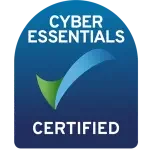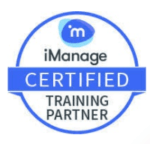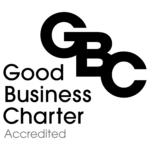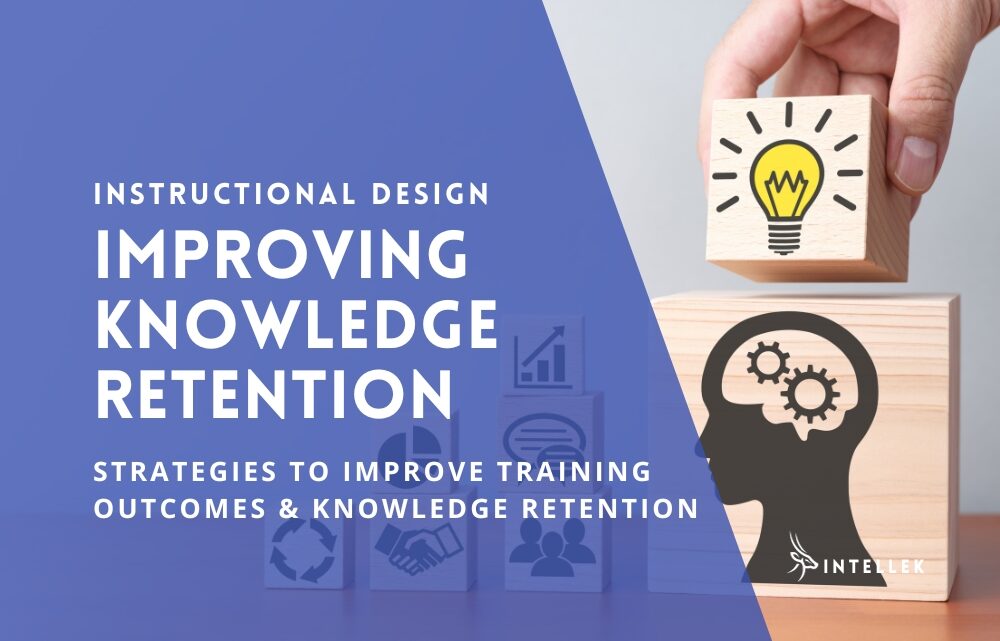
Forgetfulness hinders almost every learner’s knowledge retention after training concludes. Cramming the night before an assessment and makeshift brush-up sessions often seem like the only way for people to recall key information. But what if trainers could design their instruction so that skills, knowledge, and behaviors genuinely stick in learners’ minds for the long term?
Getting critical content to lodge permanently in an employee’s memory, instead of fading days or weeks later, would transform what training departments can accomplish. This article dives into the cognitive science behind forgetting, and more importantly, the research-backed teaching methods to bolster knowledge retention.
Drawing from disciplines like educational psychology, instructional design, and the learning sciences, we lay out strategies that any corporate trainer can use to dramatically improve the durability of learning outcomes over 6 months, a year, or more.
Spaced repetition, practice opportunities with feedback, and tying content to real work applications are just a taste of practical techniques grounded in decades of empirical study. When trainers adopt science-driven design principles, employees retain key information not just through the end of a workshop but for the long haul.
The insights provided here can launch corporate training beyond short-term memorization into genuinely sticky skill and knowledge retention. Learning programs could produce personnel who develop mastery, recall, and behavior change benchmarks not as an exception but as the norm! Any instructional designer wondering how to get employee development to last needs to understand the methodology and evidence this article summarizes.
IN THIS ARTICLE...
Techniques to Counteract the Forgetting Curve
A seminal finding that guides modern instructional methodology is what’s known as the forgetting curve. Pioneering psychological research in the late 1800s first quantified a mathematical relationship: without review, humans tend to halve their memory of newly learned material in just days or weeks, before forgetting the rest gradually (Ebbinghaus, 1885).
However, techniques exist to counteract this effect…
Spaced repetition leverages intervals of practice, review, and re-exposure to recently learned content to stimulate recall at optimal times. Counter to cramming, properly spaced review sessions – say triggering key content every 2 weeks after an initial workshop – can nearly eliminate forgetting over extended periods. One meta-analysis found retention can improve twofold to threefold with optimal spacing (Cepeda et al, 2008).
Power of Spaced Repetition to Aid Learning Retention
As noted above, spaced repetition leverages memory science to trigger review and reexposure at optimal intervals. Rather than cramming training material all at once or allowing it to be forgotten after a one-off info dump, spaced repetition uses scheduling algorithms to consolidate memories durably.
Top Tip: After an initial 4-hour compliance workshop, email reminders with key content could be spaced across 2 days later, 1 week later, 2 weeks later, 1 month later, and so on.
However spaced repetition goes beyond manual calendar reminders through modern learning technology as well. Sophisticated training platforms can now personalize optimal intervals per learner, test knowledge gaps with questions, and adaptively surface microlearning style content.
Beyond knowledge retention, spaced repetition saves massive learner time otherwise spent relearning forgotten material. Given its advantages, instructional designers are beginning to consider spaced repetition a crucial component in helping employees cross the chasm from short-term performance to genuinely extended expertise.
Cognitive Benefits of Active Learning Approaches
Instructional designers focusing on corporate training benefit significantly from understanding the cognitive advantages of active learning over passive lecture-based approaches. It allows them to design training programs that optimize engagement, retention, critical thinking, and practical application of knowledge, aligning with the needs and preferences of the target audience.
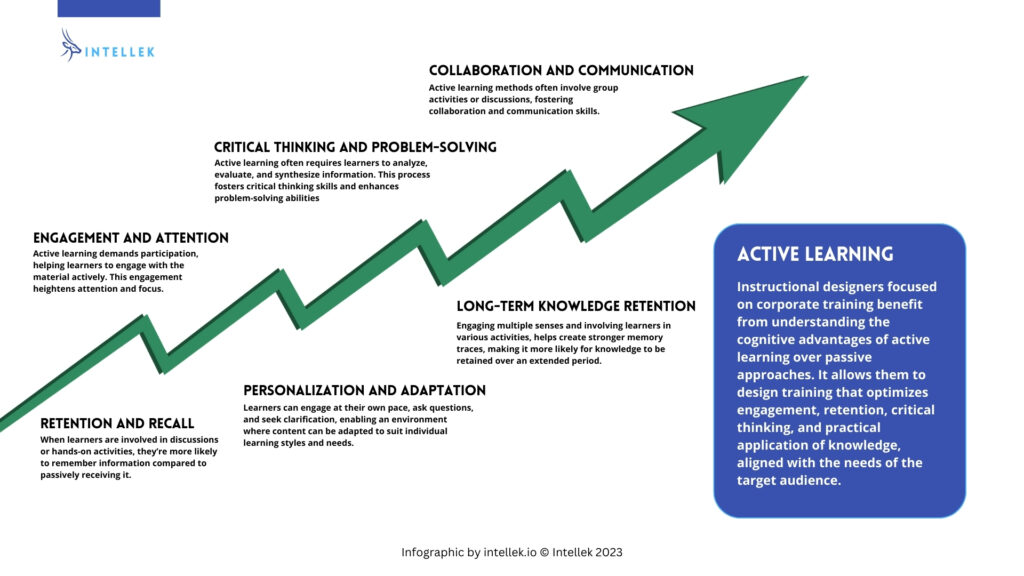

Here’s a breakdown:
1. Engagement and Attention
Active learning methods demand participation, encouraging learners to engage with the material actively. This engagement heightens attention and focus compared to passively listening to lectures. When learners are actively involved, they’re more likely to stay attentive and retain information.
2. Training Retention and Recall
When learners are involved in discussions, problem-solving, or hands-on activities, they’re more likely to remember and retrieve information compared to passively receiving it through lectures. The act of doing, discussing, or teaching reinforces memory and knowledge retention.
3. Critical Thinking and Problem-Solving
This method often requires learners to analyze, evaluate, and synthesize information. This process fosters critical thinking skills and enhances problem-solving abilities, which are vital in corporate settings where the practical application of knowledge is crucial.
4. Personalization and Adaptation
Learners can engage at their own pace, ask questions, and seek clarification, fostering an environment where content can be adapted to suit individual learning styles and needs.
5. Collaboration and Communication Skills
Active learning methods often involve group activities or discussions, fostering collaboration and communication skills. In a corporate environment, where teamwork is essential, these skills become particularly valuable.
6. Long-term Knowledge Retention
Engaging multiple senses and involving learners in various activities, helps create stronger memory traces, making it more likely for knowledge to be retained over an extended period.
How Multimedia & Interactivity Impact Engagement
Simply presenting employees with static information often fails to build genuine competency. However, rich multimedia enabled through modern learning technology along with interactivity are shown to deepen engagement and recall.
As an example, an instructional simulation that allows learners to visually spot risks in a warehouse environment first-hand leverages multimedia formats. Compared to text descriptions, these enable visual and even kinesthetic encoding of the content.
Interleaving questions, decision points, and feedback mechanisms avoid passive consumption by keeping employees actively processing. Tools like augmented and virtual reality take such interactivity even further for visceral engagement.
Beyond factual recall though, the most significant gains with multimedia-based training are higher-order thinking like critical judgment, evaluated through situational assessments.
Real-World Examples & Problem-Based Learning
Instructional design that connects directly to employees’ actual work and responsibilities makes knowledge retention intrinsically easier. Adult learners especially tune out to dry, theoretical material not tied to practice. Rather than abstract concepts, leveraging real-world case studies, scenarios, and problem-solving activities grounds content in meaning.
For example, customer service training could feature recorded calls discussing product issues identical to the ones trainees face day-to-day. Breaking into small groups to brainstorm solutions to open-ended problems through roleplay then activates critical thinking.
Such situational relevance promotes retention not through memorization tricks but because the knowledge genuinely makes a difference in better performance. The ultimate goal is to close the gap between knowing information and applying it on the job.
Training should target the knowledge that translates directly into skills employees can demonstrate and measurable results they can produce in their real work. Knowledge retention should specifically enable observable changes in workplace behavior and job performance.
Practice & Feedback to Solidify Understanding
Integrating effective practices, valuable feedback mechanisms, and meaningful assessments into the training curriculum is essential. These elements not only ensure comprehension but also foster a culture of continuous learning and improvement within the corporate environment.
Practice for Skill Development
Practice provides a hands-on approach for learners to apply theoretical knowledge to real-world scenarios. Designing exercises or simulations relevant to the corporate environment allows learners to practice and refine skills they’ll directly use in their roles.
Feedback for Improvement
Constructive feedback is crucial for learners to understand where they excel and where they need improvement. Detailed, timely, and specific feedback helps learners adjust their approach, correct mistakes, and reinforce correct behaviors.
Assessment for Learning Validation
Assessments serve multiple purposes. They validate the understanding of the material, allowing both learners and trainers to gauge comprehension. Well-designed assessments not only test knowledge but also reinforce learning by requiring recall and application of concepts.
Adaptation and Customization
Feedback from assessments can guide the customization of future training. Identifying areas where learners struggle or excel allows instructional designers to adapt the content, adjust the learning pace, or modify instructional strategies to better suit the learners’ needs.
Encouraging Self-Assessment and Reflection
Encouraging learners to self-assess and reflect on their progress fosters a sense of responsibility for their learning. It enables them to identify their strengths and weaknesses, set goals for improvement, and take ownership of their development.
Continuous Improvement
Incorporating iterative feedback loops within the training framework ensures continuous improvement. Regular assessments and feedback enable adjustments, leading to enhanced training programs and improved learning outcomes over time.
Team Projects & Interactions that Deepen Learning
While training has traditionally focused on individual mastery, collaborative team activities tap into the power of social learning. When peers explain concepts to one another in groups, this verbal externalization cements comprehension much more than a solitary review. Through dialogue, employees surface knowledge gaps and clarify misunderstandings in the moment.
Designing practice scenarios for small teams rather than individual assessments also typically boosts engagement through friendly competition. Learners tackle problems actively via roleplay, building team communication skills alongside technical capabilities. Carefully structured team projects force deeper information processing and analysis too.
Help Learners Transfer Knowledge to Unusual Situations
Effective training should build skills that employees can apply in new, unfamiliar situations. Some methods to support that:
- Use a wide range of case studies and scenarios that have differences “on the surface” but share similar underlying principles. For example, customer service representatives could practice resolving complaints across phone calls, emails, feedback forms, and social media comments. This helps them abstract core techniques for dispute resolution rather than narrow solutions for one format.
- Randomize or rotate role-playing scenarios so employees encounter a diversity of situations rather than only what is predictable. This helps them apply broader principles to unique variations.
- Use simplified models and examples that demonstrate real-world processes. Even complex systems can be metaphorically explained to convey the transferable essence. For example, computer algorithms could be miniaturized into children’s board games to show similar game theory dynamics.
If we learn information while stuck in rigid contexts, it remains brittle in our minds. However, exposing corporate learners to wide variability strengthens the adaptability and durability of retaining knowledge.
Your Takeaways for Durable Skill Building
While knowledge retention falters as the days pass, this pattern need not sentence workplace learning initiatives to failure. This is just human nature – our memories tend to fade with time. However, by using science-backed training methods, companies can dramatically improve long-term learning and skill retention.
Techniques like spacing out training instead of cramming everything in 1 day, using multimedia activities rather than lectures, relating information to real-world examples, and providing opportunities to practice material in diverse situations have research showing they cement knowledge for the long run. Workers can retain key skills not just for the next week but for continued improved performance over months and years ahead.
The strategies summarized here give corporate training designers proven tools to make development programs genuinely stick. This enables organizations to build employee expertise efficiently through time, rather than continually retraining concepts that fade quickly. Applying such methods turns passing information into lasting learner capability.
While forgetting some material is expected, if learning is anchored properly upfront, key training elements can compound within workers for the long haul. This creates durable workforce competencies instead of wasted potential ruled by forgetfulness.
Intellek (formerly TutorPro) is a founding member of the learning technology industry. With a presence in the USA, UK, Canada, and the EU – for over 30 years we have pioneered the development of cutting-edge eLearning software and online training solutions, with a large and diverse portfolio of international clientele.
Disclaimer: We use all the tools available including generative AI to create relevant and engaging content.

